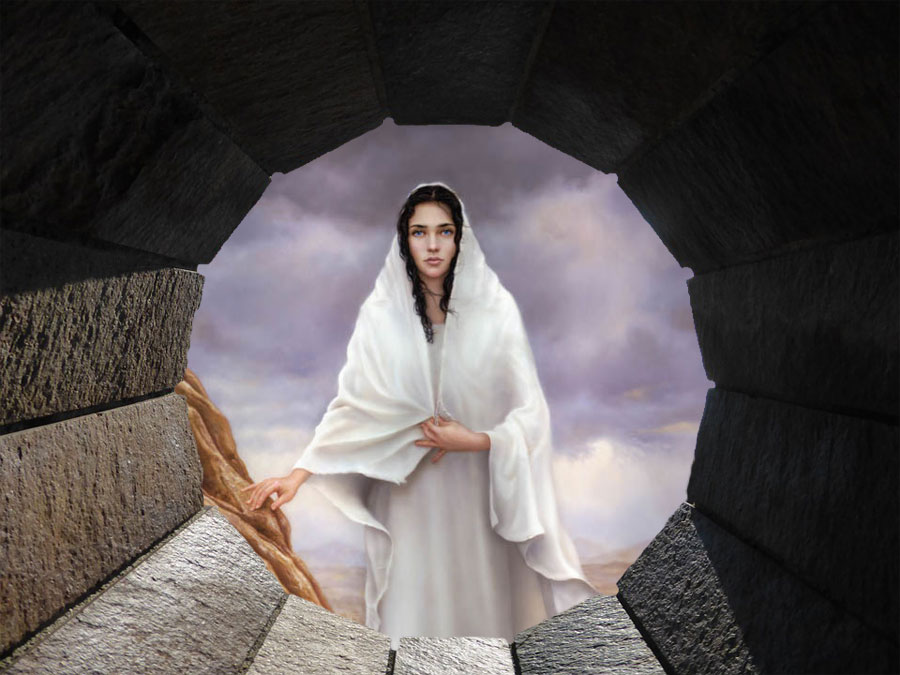Women – Disciples Of Jesus
 by Barbara Leonhard
by Barbara Leonhard
The image I have of Jesus from the Gospels is of one who went out of his way to welcome women at the table and in his ministry. Read against the backdrop of first-century, Middle Eastern, Judaic culture, Jesus’ words and actions are strikingly inclusive.
Women’s Place: In the Home
Jewish culture in the first century was decidedly patriarchal. The daily prayers of Jewish men included this prayer of thanksgiving: “Praised be God that he has not created me a woman.”
A woman’s place was thought to be in the home. Women were responsible for bearing the children, rearing them and maintaining a hospitable home. Men were not to greet women in public. Some Jewish writers of Jesus’ time, such as Philo, taught that women should never leave the home except to go to the synagogue.
Generally marrying young, a woman was almost always under the protection and authority of a man: her father, her husband or a male relative of her husband if she was a widow.
This left women in a very vulnerable position within Judaism. They had little access to property or inheritance, except through a male relative. Any money a woman earned belonged to her husband. Men could legally divorce a woman for almost any reason, simply by handing her a writ of divorce. A woman, however, could not divorce her husband.
In the area of religious practice, women were in many ways overlooked. Men were required to pray certain prayers daily, but women were not. While the study of Scripture was regarded as extremely important for men, women were not allowed to study the sacred texts. Rabbi Eliezer, a first-century teacher, is noted for saying, “Rather should the word of the Torah be burned than entrusted to a woman.”
At the Temple in Jerusalem, women were restricted to an outer court. In synagogues they were separated from the men and not permitted to read aloud. They were not allowed to bear witness in a religious court.
But Jesus defies these expectations in at least four ways, which have implications for us.
Jesus Speaks With Women in Public
First, Jesus refuses to treat women as inferior. Given the decidedly negative cultural view of women in Jesus’ time, the Gospel writers each testify to Jesus’ treating women with respect, frequently responding in ways that reject cultural norms. He recognizes their dignity, their desires and their gifts.
Jesus, for example, speaks to women in public. He steps forward in a crowd of mourners to speak with the widow at Nain, and to call her son back to life (Luke 7:11-17).
He cures a woman who had been crippled for 18 years, laying hands on her in the Temple and saying, “Woman, you are set free of your infirmity” (Luke 13:12). When the leader of the synagogue becomes indignant that Jesus has healed a woman on the Sabbath, Jesus uses a title of particular dignity for her, “daughter of Abraham” (Luke 13:16).
While the expression “son of Abraham” was often used to indicate that a male Jew was recognized as bound by covenant to God, women had never been called “daughters of Abraham.” With this title, Jesus recognizes this woman as having equal worth. In John 4:4-42, Jesus ignores two codes of behavior. He initiates a conversation with a foreigner, a Samaritan. In addition, this foreigner is also a woman. Her surprise is included in the narrative: “How can you, a Jew, ask me, a Samaritan woman, for a drink?” (John 4:9).
Jesus not only speaks with her but also enters into a prolonged dialogue, a dialogue which recognizes and honors her thirst for religious truth. Ultimately, he reveals his identity. When his disciples return, they are clearly uneasy with Jesus’ behavior. John includes the questions they are afraid to verbalize: “What are you looking for? Why are you talking with her?” (John 4:27).
The Gospel writer does not hesitate to conclude the story with a comment that, although in Jewish thought a woman’s testimony was not trustworthy, here the Samaritan woman’s excited words are heard and acted upon. “Many of the Samaritans of that town began to believe in him because of the word of the woman who testified” on his behalf (John 4:39).
Respect and Compassion
Second, Jesus refuses to view women as unclean or especially deserving of punishment. Women who were menstruating or persons who had any flow of blood were considered ritually unclean. In this condition, women were not allowed to participate in most religious rituals. Anything or anyone she touched was deemed unclean.
The most dramatic story concerning a woman in this state is the account of the woman who had a flow of blood for 12 years (Luke 8:43-48). Luke emphasizes Jesus’ compassion for the woman by the way he situates the story.
Chapter 8 features Jairus, an official of the synagogue, coming to Jesus to beg him to cure his daughter. While they are on the way, this frightened, suffering woman, who has been ill and consequently isolated for years, touches his cloak. Jesus turns his attention from the synagogue official to the woman. He wants to know who touched his garment. By religious norms, the woman’s touch—even of his cloak—rendered Jesus unclean.
If the woman expects him to be angry with her for approaching, she is greatly surprised. He says nothing of her ritual impurity, but instead addresses her as “Daughter,” says that her faith has saved her and tells her to go in peace (8:48).
Jesus recognizes the dignity of women in situations that seem by ritual law to demand judgment, for example, the sinful woman who anoints Jesus (Luke 7:36-50) and that of the woman caught in adultery (John 8:3-11).
In both cases he sees the person as someone deserving compassion. In Luke’s narrative of the anointing woman, after Jesus is touched and anointed by a woman who is a recognized sinner, we hear the expected reaction from Simon, his host. This prominent religious leader, a Pharisee, is dismayed and says, “If this man were a prophet, he would know who and what sort of woman this is who is touching him, that she is a sinner” (Luke 8:39).
Not only does Jesus tell the woman that her sins are forgiven, but he also uses her actions and the love which prompted them to teach his offended host! Jesus’ question is pointed: “Do you see this woman?” (Luke 8:44).
The question urges Simon to look beyond the categories by which he has always lived and to see her as a sincere woman, as a woman of great love.
Jesus clearly teaches that the one who keeps all the rules is not necessarily the better person. “Her many sins have been forgiven; hence, she has shown great love” (Luke 8:47).
In John’s account of the woman caught in adultery (John 8:3-11), a trap is laid for Jesus. The scribes and Pharisees who bring the woman to Jesus present the case, the judgment and the punishment, and wait to see if he will reject the Mosaic law in favor of the woman.
Jesus wisely evades the entire legal debate and confronts them instead with a more fundamental truth—that none of them is without sin. When the accusers have all left, Jesus speaks compassionately with the woman. He does not gloss over her sin, but in his refusal to condemn her, he invites her to a new place of freedom and a new image of herself.
Third, Jesus steps over expected boundaries between men and women by his acceptance of women as disciples. Unlike rabbis of his day, Jesus taught women about Scripture and his way of love. Matthew tells of Jesus’ mother and brothers asking to speak to him. “He said in reply…, ‘Who is my mother? Who are my brothers?’ And stretching out his hand toward his disciples, he said, ‘Here are my mother and my brothers’” (Matthew 12:46-50). His use of both masculine and feminine words clearly indicates that some of his disciples were women.
The familiar story of Martha and Mary in Luke 10:38-42 highlights Jesus’ acceptance and blessing of Mary’s desire to learn. She is described as one who “sat beside the Lord at his feet listening to him speak” (Luke 10:39). This is the typical position of the male disciple. To sit at the feet of a rabbi meant that a person was one of his disciples.
Martha, on the other hand, takes the expected woman’s role of providing hospitality. Perhaps she herself thinks it improper for Mary to act as a disciple. Regardless, Jesus will not deprive Mary of her opportunity. “Mary has chosen the better part and it will not be taken from her” (Luke 10:42).
Of particular interest is the fact that Jesus not only taught women, but some women traveled with him and ministered to him.
In Luke 8:1-3, Jesus is described as journeying from village to village, preaching and proclaiming the Kingdom of God. “The Twelve” were with him and several women: “Mary, called Magdalene, from whom several demons had gone out, Joanna, the wife of Herod’s steward Chuza, Susanna, and many others who provided for them out of their resources.”
Mark, too, says of the women present at Jesus’ crucifixion, “These women had followed him when he was in Galilee and ministered to him” (15:41). This picture of women disciples is astounding, given that Jewish women at this time were not to learn the Scriptures or even to leave their households.
Jesus was doing something startlingly new.
Receiving Jesus’ Self-Revelation
Fourth, not only did Jesus have women disciples, but the Gospel writers also assure us that they were prominent recipients of Jesus’ self-revelation.
Martha, who is the sister of Jesus’ friend Lazarus, in the midst of her confusion and grief over her brother’s death, struggles to name what she believes about Jesus. While they stand at the tomb, Jesus reveals to her, “I am the resurrection and the life” (John 11:25).
In all of the Gospels, women disciples are the first witnesses to the Resurrection. Mary Magdalene sees Jesus but is not believed (Mark 16:11). In John’s account (20:11-18), she recognizes Jesus when she hears herself called by name, testifying to the close relationship they had. Jesus tells her to go to the other disciples and tell them, “I have seen the Lord.”
In Matthew, Jesus appears to Mary Magdalene and the other Mary and sends them to tell the disciples that they will see him in Galilee (28:1-10). Luke’s version also has the women announce the Resurrection, but he adds, “Their story seemed like nonsense and they [the apostles] did not believe them” (24:11). The two disciples on the road to Emmaus seem to doubt the women’s story as well (Luke 24:22-24).
Lesson for Us
The Gospels point us toward including women’s voices and gifts. While we live in a time and culture far different from that of the historical Jesus, his way of welcoming and responding to women has much to teach us.
Perhaps a now-familiar parable that Jesus told about a woman captures it best. “The kingdom of heaven is like yeast that a woman took and mixed with three measures of wheat flour until the whole batch was leavened” (Matthew 13:33).
Jesus recognized that women had gifts for discipleship, and he was not afraid to call these women forth.
Posted in Other Topics, The True Life of Jesuswith comments disabled.





